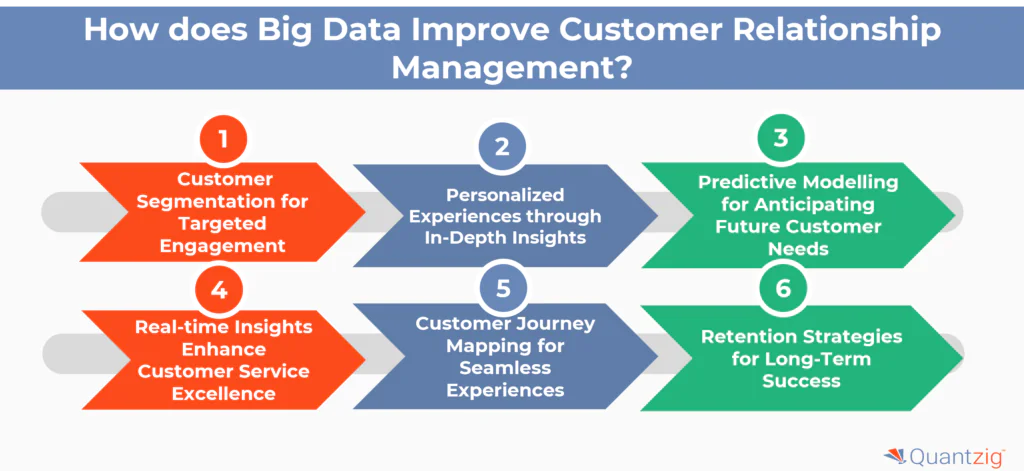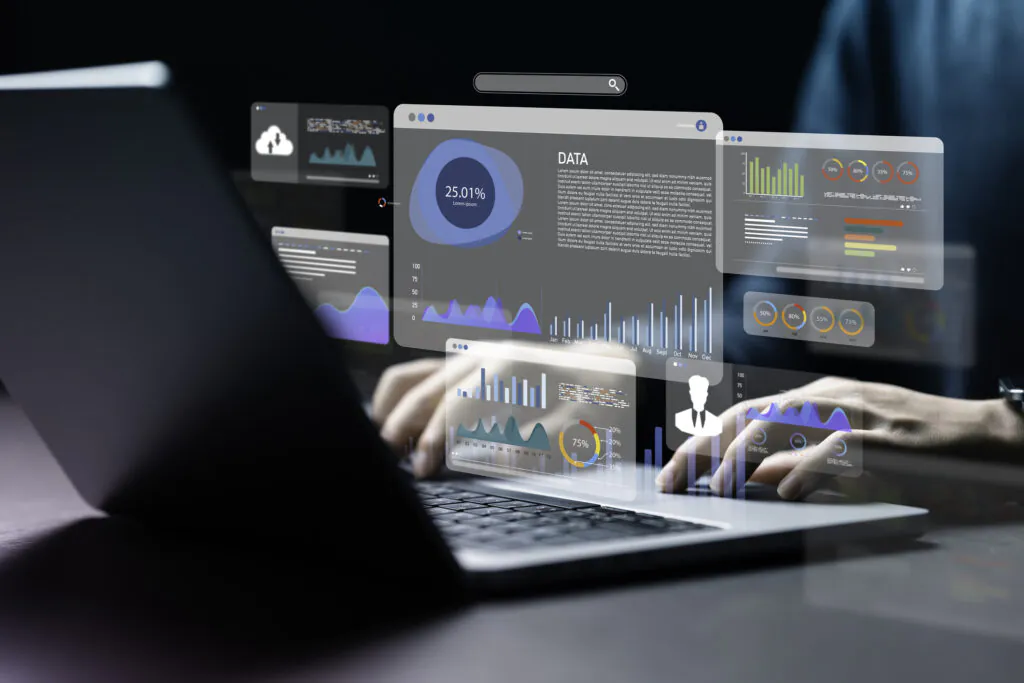Written By: Vice President, Data Analytics, Quantzig.
Table of Contents
Table of Contents
- Introduction to Big Data CRM
- How does Big Data Improve Customer Relationship Management?
- The Advantage of Big Data in CRM
- About Quantzig’s Solution
- Analysis for Customer Relations
- Conclusion
Introduction to Big Data CRM
In today’s digital world, data is king. Immense volumes of it are being generated every minute, from a multitude of sources, and the ability to identify and analyze useful information from it is key to improving operations and gaining a competitive advantage.
There are several sources of big data crm. A business generates a lot of information from many places, both from its own systems and processes and from its clients. Data analysis can help identify strengths and weaknesses, improve operational efficiency, determine consumer habits and needs, and deliver personalized offers and recommendations.
It has also been noted that social media platforms offer a wealth of information, particularly for marketing and user relations. However, this data is largely unstructured, making it more difficult to analyze. This makes it all the more necessary to find or develop software that can manage and interpret this information and put it into a more usable form.
Request a demo to experience the meaningful insights we derive from data through our analytical tools and platform capabilities. Schedule a demo today!
Request a Free DemoHow does Big Data Improve Customer Relationship Management?

1. Precision Customer Segmentation for Targeted Engagement:
It transforms customer relationship management by enabling precise segmentation through advanced analytics. Leveraging demographic, behavioral, and transactional data, businesses can categorize clients into distinct segments based on shared characteristics. This meticulous segmentation allows for tailored engagement strategies, ensuring that marketing initiatives, communication channels, and product offerings are meticulously aligned with the unique needs and preferences of each segment. By employing this tool, organizations elevate their ability to deliver relevant and personalized experiences, fostering a deeper connection between the brand and its diverse client base.
2. Personalized Experiences through In-Depth Insights:
It empowers businesses to craft personalized experiences by delving into vast datasets to extract meaningful insights. Analyzing individual behaviors, preferences, and historical interactions, organizations can deliver highly customized products, services, and marketing communications. This level of personalization enhances user satisfaction, strengthens brand loyalty, and establishes a distinctive competitive edge in the market. Through the strategic use of this tool, companies demonstrate a keen understanding of their target audience, creating a compelling narrative that resonates with individual preferences and engenders lasting positive impressions. By leveraging Big Data, businesses can gain a holistic view of their target audience by analyzing the five V’s (volume, value, variety, velocity, veracity) of data. This allows for a deeper understanding of client behavior, patterns, and trends, enabling businesses to tailor their offerings and marketing strategies accordingly.
3. Predictive Modelling for Anticipating Future Customer Needs:
The integration of this tool into customer relationship management introduces predictive model, a powerful tool for anticipating and meeting future needs. By analyzing historical patterns, businesses gain the foresight required to predict emerging trends, preferences, and market shifts. This predictive capability allows organizations to proactively adjust their product offerings, marketing strategies, and service initiatives. Businesses that harness predictive model not only stay ahead of the competition but also demonstrate a commitment to innovation and customer-centricity, contributing to the cultivation of long-term, sustainable relationships.
4. Real-time Insights Enhancing Customer Service Excellence:
It’s real-time processing capabilities revolutionize client service by providing immediate insights into the interactions. Through sentiment analysis and continuous monitoring, businesses can swiftly detect and address client issues, concerns, or feedback. This agile responsiveness not only resolves problems promptly but also contributes to enhanced customer satisfaction and loyalty. Real-time insights derived from this tool empower service teams to anticipate and respond to customer needs with unparalleled efficiency, positioning the organization as a customer-centric entity committed to delivering excellence across all touchpoints. This tool empowers businesses to create personalized campaigns and communication strategies. By segmenting target audience based on their preferences, demographics, and past interactions, businesses can deliver targeted and relevant content through offline and online media. This personalized approach enhances customer satisfaction, loyalty, and overall experience.
5. Comprehensive Customer Journey Mapping for Seamless Experiences:
This service facilitates a comprehensive mapping of the journey, offering businesses unparalleled visibility into the various touchpoints across diverse channels. By analyzing this end-to-end user experience, organizations can identify potential pain points, optimize processes, and create a seamless and enjoyable journey for their clients. This meticulous optimization not only enhances the overall user experience but also strengthens the brand relationship. Businesses leveraging it for customer journey mapping gain valuable insights into the audience perspective, allowing them to align their strategies with the evolving expectations and preferences of their target audience.
6. Retention Strategies for Long-Term Success:
This tool plays a pivotal role in developing in-depth retention strategies. Through advanced services, businesses can identify at-risk customers using sophisticated churn prediction models. Armed with this insight, organizations can proactively implement targeted retention initiatives, such as personalized offers, loyalty programs, or exclusive perks. This proactive approach not only retains valuable customers but also underscores the company’s dedication to customer satisfaction. By utilizing this platform for customer retention, organizations demonstrate agility and responsiveness, reinforcing a positive and enduring relationship with their customer base. It enables the development of predictive models and algorithms that can identify potential sales opportunities. By analyzing transaction data, internet activity, and social media information, businesses can identify leads, prospects, and projects that align with their product or service offerings. This helps salespeople prioritize their efforts and focus on high-value accounts and decision-makers.
Experience the advantages firsthand by testing a customized complimentary pilot designed to address your specific requirements. Pilot studies are non-committal in nature.
Request a Free TrialThe advantage of such an overwhelming amount of data, of course, is having such a large pool of information to work from. With effective analysis, patterns can be found that will yield insights into consumers’ habits and preferences, providing feedback on the company’s actions and offerings and allowing the business to provide customized offerings and interactions to customers.
About Quantzig’s Solution
1. Revolutionizing Customer Relationship Management
In the ever-evolving landscape of small businesses, the integration of this tool into Customer Relationship Management (CRM) emerges as a transformative force. As businesses increasingly rely on web-driven insights and machine logs, the Senior Vice President of our Product, a key decision-maker in this paradigm shift, emphasizes the significance of leveraging data to gain a holistic view of current customers, future customers, and prospects.
2. Unveiling the Power of the Five V’s: Volume, Value, Variety, Velocity, Veracity
At the core of effective CRM lies the understanding of the Five V’s. Algorithms and predictive models, strategically implemented by CRM experts, dissect vast datasets to extract actionable intelligence. This approach, championed by industry leaders and managing directors, ensures that CRM initiatives are not only real-time but also grounded in the fundamentals of volume, value, variety, velocity, and veracity.
3. Precision Targeting: From Sales Pipelines to Segmentation Tools
In the competitive realm of sales, the effectiveness of salespeople is magnified through advanced CRM tools. Sales pipelines are optimized as accounts, industries, and company sizes are meticulously analyzed. With smart filters and segmentation tools, businesses gain the ability to sift through transaction data, ensuring precision targeting of decision-makers, contact people, and prospects. This strategic approach is essential for converting leads into revenue and deciphering the intricate web of social media information.
4. Little Data, Big Impact: Tailoring Products and Services for Maximum Engagement
The strategic incorporation of “little data” from sources like Twitter, Facebook, and customer feedback is paramount for crafting personalized customer experiences. Quantzig’s approach ensures that customer insights from historical records and projects are seamlessly integrated, enhancing CRM strategies. From tailoring products and services to optimizing revenue projections, the integration of little information into the CRM framework becomes a cornerstone for deriving actionable insights and ensuring a positive business outcome.
In the ever-expanding global market, the amalgamation of advanced CRM tools, and strategic insights positions businesses at the forefront of innovation. Quantzig’s comprehensive CRM approach, endorsed by industry leaders and seamlessly integrating various sources, propels organizations into a future where precision, adaptability, and engagement are not just buzzwords but the cornerstones of success.
Analysis for Customer Relations
In an age where consumers have easy access to reviews and opinions and expect prompt attention and response from brands, managing customer relations is essential. Bad customer experience can have a much bigger impact than in the past, and a good one can bring positive media attention and new business.
One thing that big data analysis can do is gauge the effect of a campaign or business strategy both before and after implementation. Data from previous efforts can be used to determine how a future campaign might be received, and tailor it to suit consumer preferences. The same can be done for products and services as understanding consumer preferences make it easier to build a product that will satisfy the greatest number of people possible. This can save time and money when it comes to planning and executing projects, and also result in happier customers.
Get started with your complimentary trial today and delve into our platform without any obligations. Explore our wide range of customized, consumption driven analytical solutions services built across the analytical maturity levels.
Start your Free Trial now
It can also allow businesses to customize the consumer experience in a way that would formerly have been far too time-intensive and impractical. Recommendations and personalized coupons have become commonplace and often expected, but it is thanks to big data crm that they are possible on a large scale. Promotions like these encourage consumers to spend more money, while also making those consumers happy, as they are given deals on products or services that they care about. And if a business offers a personalized service and rewards for shopping, the consumer’s switching costs increase, and they are more likely to stay with that business rather than look for other options.
Social media data mining and campaigning can be taken too far, however. Privacy and customers’ expectations of it need to be taken into account when analyzing planning campaigns. Otherwise, a brand can come across as invasive and creepy, driving people away rather than bringing in more business.
Conclusion
In conclusion, this is a valuable tool for every aspect of customer relationship management. It helps businesses discover their target demographic and learn about consumer priorities. It determines public opinions on products, services, marketing campaigns, and more. It allows companies to tailor their marketing and promotions to their audience, and to provide a level of personalized service that would otherwise be impossible. With more and more businesses adopting big data analytics, it’s essential to take advantage of this tool to remain competitive in the market. Big Data improves CRM by providing businesses with actionable data, advanced CRM tools, and real-time insights. It enables businesses to analyze individuals’ behavior, identify sales opportunities, and engage them in a personalized manner, ultimately leading to better products, services, and operational activities.





